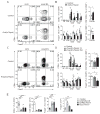Tissue adaptation of regulatory and intraepithelial CD4⁺ T cells controls gut inflammation
- PMID: 27256884
- PMCID: PMC4968079
- DOI: 10.1126/science.aaf3892
Tissue adaptation of regulatory and intraepithelial CD4⁺ T cells controls gut inflammation
Abstract
Foxp3(+) regulatory T cells in peripheral tissues (pT(regs)) are instrumental in limiting inflammatory responses to nonself antigens. Within the intestine, pT(regs) are located primarily in the lamina propria, whereas intraepithelial CD4(+) T cells (CD4(IELs)), which also exhibit anti-inflammatory properties and depend on similar environmental cues, reside in the epithelium. Using intravital microscopy, we show distinct cell dynamics of intestinal T(regs) and CD4(IELs) Upon migration to the epithelium, T(regs) lose Foxp3 and convert to CD4(IELs) in a microbiota-dependent manner, an effect attributed to the loss of the transcription factor ThPOK. Finally, we demonstrate that pT(regs) and CD4(IELs) perform complementary roles in the regulation of intestinal inflammation. These results reveal intratissue specialization of anti-inflammatory T cells shaped by discrete niches of the intestine.
Copyright © 2016, American Association for the Advancement of Science.
Figures




Comment in
-
IMMUNOLOGY. Converting to adapt.Science. 2016 Jun 24;352(6293):1515-6. doi: 10.1126/science.aag1719. Science. 2016. PMID: 27339967 No abstract available.
Similar articles
-
CD4+Foxp3+ regulatory T cell expansion induced by antigen-driven interaction with intestinal epithelial cells independent of local dendritic cells.Gut. 2009 Feb;58(2):211-9. doi: 10.1136/gut.2008.151720. Epub 2008 Oct 2. Gut. 2009. PMID: 18832523
-
FoxP3(+)CD4(+)CD25(+) T cells with regulatory properties can be cultured from colonic mucosa of patients with Crohn's disease.Clin Exp Immunol. 2005 Sep;141(3):549-57. doi: 10.1111/j.1365-2249.2005.02876.x. Clin Exp Immunol. 2005. PMID: 16045746 Free PMC article.
-
Lineage re-commitment of CD4CD8αα intraepithelial lymphocytes in the gut.BMB Rep. 2016 Jan;49(1):11-7. doi: 10.5483/BMBRep.2016.49.1.242. BMB Rep. 2016. PMID: 26592937 Free PMC article. Review.
-
Analysis of intestinal lymphocytes in mouse colitis mediated by transfer of CD4+, CD45RBhigh T cells to SCID recipients.J Immunol. 1997 Apr 1;158(7):3464-73. J Immunol. 1997. PMID: 9120308
-
CD4CD8αα IELs: They Have Something to Say.Front Immunol. 2019 Oct 9;10:2269. doi: 10.3389/fimmu.2019.02269. eCollection 2019. Front Immunol. 2019. PMID: 31649659 Free PMC article. Review.
Cited by
-
The renaissance of oral tolerance: merging tradition and new insights.Nat Rev Immunol. 2024 Sep 6. doi: 10.1038/s41577-024-01077-7. Online ahead of print. Nat Rev Immunol. 2024. PMID: 39242920 Review.
-
Chemotherapy-induced intestinal epithelial damage directly promotes galectin-9-driven modulation of T cell behavior.iScience. 2024 May 22;27(6):110072. doi: 10.1016/j.isci.2024.110072. eCollection 2024 Jun 21. iScience. 2024. PMID: 38883813 Free PMC article.
-
Myeloid Cells and Sphingosine-1-Phosphate Are Required for TCRαβ Intraepithelial Lymphocyte Recruitment to the Colon Epithelium.J Immunol. 2024 Jun 1;212(11):1843-1854. doi: 10.4049/jimmunol.2200556. J Immunol. 2024. PMID: 38568091
-
T cell and bacterial microbiota interaction at intestinal and skin epithelial interfaces.Discov Immunol. 2023 Nov 25;2(1):kyad024. doi: 10.1093/discim/kyad024. eCollection 2023. Discov Immunol. 2023. PMID: 38567051 Free PMC article. Review.
-
Pathways and mechanisms of CD4+CD8αα+ intraepithelial T cell development.Trends Immunol. 2024 Apr;45(4):288-302. doi: 10.1016/j.it.2024.02.006. Epub 2024 Mar 20. Trends Immunol. 2024. PMID: 38514370 Review.
References
Publication types
MeSH terms
Substances
Grants and funding
LinkOut - more resources
Full Text Sources
Other Literature Sources
Molecular Biology Databases
Research Materials

